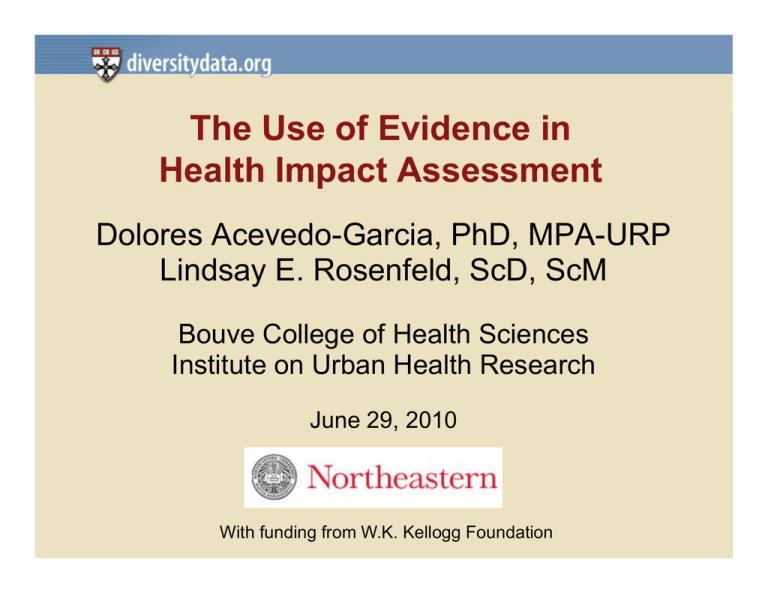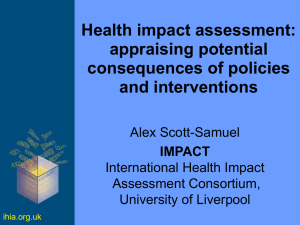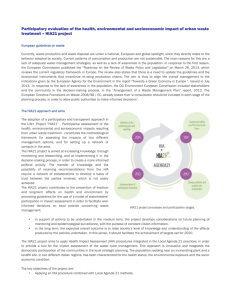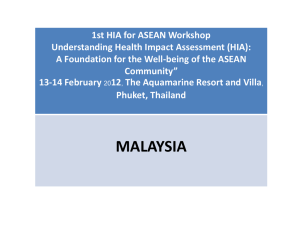The Use of Evidence in Health Impact Assessment p Dolores Acevedo-Garcia, PhD, MPA-URP
advertisement

The Use of Evidence in Health Impact p Assessment Dolores Acevedo-Garcia, PhD, MPA-URP Li d Lindsay E E. R Rosenfeld, f ld S ScD, D S ScM M Bouve College of Health Sciences Institute on Urban Health Research June 29, 2010 With funding from W.K. Kellogg Foundation O tli Outline • Role of evidence in HIA • Types of evidence used in HIA • Evidence on effectiveness of HIA Health Impact Assessment (HIA) To stem the rising tide of chronic disease and create safe, thriving communities, health needs to be regularly factored into policy and program decisions in sectors that do not traditionally traditionall foc focus s on health outcomes. The Health Impact Project http://www healthimpactproject org/hia http://www.healthimpactproject.org/hia Features of HIA that influence role of evidence • Focuses on complex interventions/policy and their diverse effects on social determinants of health. • Includes multiple research questions • Overview of health effects through multiple pathways (e.g. pollution, housing, open space) • Involves diversity of evidence (disciplines, study designs, quality criteria) Mindell et al., 2004, Enhancing the evidence base for health impact assessment. Journal of Epidemiology and Community Health Features of HIA that influence role of evidence • Involves a broad range of stakeholders • Often required within short timescales and limited resources • Involves pragmatism to assemble information for decision makers regardless of the quality of the evidence. Mindell et al., 2004, Enhancing the evidence base for health impact assessment. Journal of Epidemiology and Community Health What is evidence evidence-based based decision making? Use of evidence in medicine Evidence-based Evidence based medicine is the conscientious, explicit and judicious use of current best evidence in making decisions about the care of individual patients. The practice of evidence evidence-based based medicine means integrating individual clinical expertise with the best available external clinical evidence from systematic research. research The Cochrane Collaboration Use of evidence in public health Evidence-based approaches (those explicitly li itl lilinked k d tto th the b bestt available il bl scientific evidence and reflecting community preferences and feasibility) are increasingly used to inform health policy decision making on the burden of a disease attributable to particular causes, policies that might g work interventions and p to confront those causes, and issues of community fit and feasibility. Fielding & Briss, 2006, Promoting evidence-based public health policy: can we have better evidence and more action? Health Affairs F d l guidelines Federal id li - OMB … we we’re re using a similar similar, two two-tiered tiered approach approach. First, we’re providing more money to programs that generate results backed up by strong evidence. id Th t’ the That’s th ttop ti tier. Then, Th ffor an additional group of programs, with some supportive evidence but not as much, we’ve we ve said: Let’s try those too, but rigorously evaluate them and see whether they work. Over time, we hope th t some off those that th programs will ill move iinto t th the top tier — but, if not, we’ll redirect their funds to other,, more promising p g efforts. OMB, June 8 and October 7, 2009 Memoranda Stages of HIA: How is evidence used? • Screening (establish health relevance of policy/program) • Scoping (identifies key health issues; exclusion criteria; public concerns) ( ,p , • Assessment (establish baseline, prediction, significance, mitigation; review of evidence) Communication of HIA findings and • Communication of HIA findings and recommendations • Evaluation and monitoring (can produce Evaluation and monitoring (can produce further evidence) St Stages off HIA: HIA How H is i evidence id used? d? • Screening • Emerging selection criteria criteria, e e.g. g Human Impact Partners, 2009, Considerations for the Selection of Appropriate Policies Policies, Plans, or Projects for Analysis using Health Impact Assessment St Stages off HIA: HIA How H is i evidence id used? d? • Scoping • • • • • What health impacts are considered? What health impacts are considered? Exclusion criteria Logic model? Sources? Likely size of effect? Less direct impacts? Inputs p Activities Outputs p Revise D l Development t review process Inclusion of HIA review process Safe Sidewalks Health Dept. Public Outcomes Ai P Air Pollution ll ti Traffic Volume Recreation Facilities Xeriscaping Political Entities Impacts p Green Space D l Developers Planning Dept. Components p Pedestrian safety Pedestrian – vehicle collisions Connectivity Implementation of HIA design recommendation Proximity to Activity Center Proximity to Schools Radon Resistant Construction Walkability Ob it Obesity CVD Physical Activity Mi d Use Mixed U Zoning Revise Land Development Code Health Effects Lung Disease Noise Healthy ea t y Design Community Stress HBP Expedited permitting p g Development of a Health Impact Assessment (HIA) Protocol For Polk County, Florida 2005-2006 Stages of HIA: How is evidence used? • Assessment (review of evidence) Broad definition of evidence Taking an e evidence idence based approach does not mean relying on or privileging only one kind of method such as the randomized controlled trial method, trial. It does not mean that there is only one hierarchy of evidence, and it does not mean an epistemological rejection of subjective positions or methods. The evidence based approach to SDH categorically t i ll rejects j t th the notion ti off a single i l hierarchy of evidence. Kelley and Bonnefoy, 2007, The social determinants of health: Developing an evidence base for political action, Report for WHO Comission on Social Determinants of Health Broad definition of evidence • Use of evidence in HIA may be different than use of evidence in health care (e.g. Cochrane Collaborative), education, policy (e.g. Coalition for Evidence‐based Policy) • Those disciplines tend to give more weight to evidence from studies with an experimental design. But “rigorous evidence” can be used in HIA • How to aggregate evidence? • Types of evidence used in HIA • (Systematic) reviews • Is review method specified? • Meta analysis? • Simulations (decision analysis) • Input from stakeholders (community survey, g p) y focus groups)—may have elements of Community‐based Participatory Research ( (CBPR). ) • Other, e.g. field observations St Stages off HIA: HIA How H is i evidence id used? d? • Communication of HIA findings and recommendations Grey literature Grey literature • Peer reviewed • Political process • St Stages off HIA: HIA How H is i evidence id used? d? • EEvaluation and monitoring (can produce l ti d it i ( d further evidence) • HIA is not an evaluation (often prospective). • An evaluation may be conducted to assess health effects of selected alternative (i.e actual course of action)—but time frame may be a barrier. • HIA predictions could be assessed against p g actual outcomes—very rarely done. HIA of Concord Naval Weapons Station Re Reuse Project (Human Impact Partners, 2009) • 5,028-acre site owned by the Navy for over 60 years Property will be redeveloped to include residential and commercial development, and parks/open space • 7 different alternatives, each proposing a unique mix of land uses • HIP partnered with Community Coalition for a Sustainable Concord (CCSC) • While there are obvious environmental health implications related to the CNWS Site’s former use as a military ammunitions storage site, HIP and CCSC decided during g the scoping p g stage g that residual chemical contamination in groundwater and soil contamination would not be included in the HIA. We absolutely believe that these potential health concerns are important and are to be considered as additive effects to the other health impacts discussed in this report. However, this type of analysis is outside of the technical expertise of the HIA team, project timeline and budget. Environmental i investigation ti ti and d remediation di ti off th the site it iis subject bj t tto ffederal d l regulatory oversight (…) This assessment also excludes comprehensive air quality and noise analyses. Air quality and noise issues were not near the top of the community’s community s list of concerns concerns, and are discussed but not focused on. We suggest that these topics be covered more extensively in the final Environmental Impact Report. Human Impact Partners, January 2009, Concord Naval Weapons Station Reuse Project Health Impact Assessment Piecing evidence together • Concord Naval Weapons Station Reuse Project Health Impact Assessment • Simulated effects on jobs/incomes • Compared with availability of affordable housing • Discussed possible health implications of limited availability of affordable housing • qualitative lit ti narrative ti nott a simulation i l ti off h health lth effects A Child Health Impact Assessment of Energy Costs and the Low Income Home Energy Assistance Program (Child HIA Working Group, 2007) • HIA of federal Low-Income Energy Assistance Program g – Gap in 2007 in Massachusetts due to decrease in benefit levels • Literature review (method?); interviews with stakeholders; qualitative assessment of impacts Evidence on effectiveness of HIA • Effecti Effectiveness eness defined as as: ‘If and ho how the HIA approach informs the decision making process and in particular and, particular, if it improves health and reduces health inequalities.’ • 2002 review: cast wide net for literature search but onlyy one studyy met critical appraisal pp criteria: – McIntyre, L. and Petticrew M. (1999). Methods of Health Impact Assessment: a literature review Taylor & Quigley, 2002, HIA: A review of reviews, UK, Health Development Agency Evidence on effectiveness of HIA There is currentlyy no review-level evidence available to demonstrate if and how the HIA approach informs the decision making process and, d iin particular, ti l if it iimproves health and reduces health inequalities. Taylor & Quigley, 2002, HIA: A review of reviews, UK, Health Development Agency Evidence on effectiveness of HIA • Analysis of HIA 1999-2009 • HIA defined as “directly effective” if decisions were modified and decision-makers acknowledged health issues. • Of 35 HIA, 25 “changed the project” and 9 “educated the decision maker”. Wendel et al. In preparation. Fi l points Final i t • HIA requires q summarizing g evidence but review methods have not been formalized. • There is room for considering different types of evidence and for different methods to review each type. • How different types of evidence are aggregated/weighted is often not made explicit qualitative judgment? explicit—qualitative • Each step of HIA could benefit from defining methods that can be used to assess evidence






